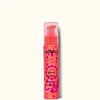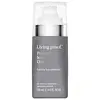What's inside
What's inside
 Key Ingredients
Key Ingredients

No key ingredients
 Benefits
Benefits

 Concerns
Concerns

 Ingredients Side-by-side
Ingredients Side-by-side

Water
Skin ConditioningEthylhexyl Stearate
EmollientPropylene Glycol Dibenzoate
Skin ConditioningPPG-3 Benzyl Ether Myristate
EmollientHelianthus Annuus Seed Oil
EmollientIsohexadecane
EmollientQuaternium-91
Isoamyl Laurate
EmollientPolyquaternium-4
Hydroxypropyl Guar
Emulsion StabilisingHydrogenated Castor Oil/Sebacic Acid Copolymer
EmollientIsododecane
EmollientC13-15 Alkane
SolventLinoleamidopropyl Ethyldimonium Ethosulfate
Linoleamidopropyl Dimethylamine Dimer Dilinoleate
Skin ConditioningAmaranthus Caudatus Seed Extract
Skin ConditioningParfum
MaskingDiisostearyl Malate
EmollientHydroxyethylcellulose
Emulsion StabilisingGlycerin
HumectantPhytosteryl/Octyldodecyl Lauroyl Glutamate
Skin ConditioningSodium PCA
HumectantPCA Ethyl Cocoyl Arginate
MoisturisingArginine
MaskingGlycine
BufferingAlanine
MaskingSerine
MaskingValine
MaskingIsoleucine
Skin ConditioningProline
Skin ConditioningThreonine
Histidine
HumectantPhenylalanine
MaskingHydroxyacetophenone
AntioxidantTrisodium Ethylenediamine Disuccinate
Caprylyl Glycol
EmollientGlycolic Acid
BufferingAspartic Acid
MaskingSodium Lactate
BufferingEthyl Lauroyl Arginate Hcl
Skin ConditioningZea Mays Starch
AbsorbentHydrolyzed Soy Protein
HumectantStearamidopropyl Dimethylamine
EmulsifyingPentylene Glycol
Skin ConditioningGluconolactone
Skin ConditioningPropanediol
SolventCynara Scolymus Leaf Extract
Skin ConditioningCitronellol
PerfumingAlpha-Isomethyl Ionone
PerfumingGeraniol
PerfumingHydroxycitronellal
PerfumingCitral
PerfumingLimonene
PerfumingWater, Ethylhexyl Stearate, Propylene Glycol Dibenzoate, PPG-3 Benzyl Ether Myristate, Helianthus Annuus Seed Oil, Isohexadecane, Quaternium-91, Isoamyl Laurate, Polyquaternium-4, Hydroxypropyl Guar, Hydrogenated Castor Oil/Sebacic Acid Copolymer, Isododecane, C13-15 Alkane, Linoleamidopropyl Ethyldimonium Ethosulfate, Linoleamidopropyl Dimethylamine Dimer Dilinoleate, Amaranthus Caudatus Seed Extract, Parfum, Diisostearyl Malate, Hydroxyethylcellulose, Glycerin, Phytosteryl/Octyldodecyl Lauroyl Glutamate, Sodium PCA, PCA Ethyl Cocoyl Arginate, Arginine, Glycine, Alanine, Serine, Valine, Isoleucine, Proline, Threonine, Histidine, Phenylalanine, Hydroxyacetophenone, Trisodium Ethylenediamine Disuccinate, Caprylyl Glycol, Glycolic Acid, Aspartic Acid, Sodium Lactate, Ethyl Lauroyl Arginate Hcl, Zea Mays Starch, Hydrolyzed Soy Protein, Stearamidopropyl Dimethylamine, Pentylene Glycol, Gluconolactone, Propanediol, Cynara Scolymus Leaf Extract, Citronellol, Alpha-Isomethyl Ionone, Geraniol, Hydroxycitronellal, Citral, Limonene
Ingredients Explained
These ingredients are found in both products.
Ingredients higher up in an ingredient list are typically present in a larger amount.
Citronellol is used to add fragrance/parfum to a product. It is often derived from plants such as roses. In fact, it can be found in many essential oils including geranium, lavender, neroli, and more. The scent of Citronellol is often described as "fresh, grassy, and citrus-like".
Since the Citronellol molecule is already unstable, Citronellol becomes irritating on the skin when exposed to air.
Citronellol is a modified terpene. Terpenes are unsaturated hydrocarbons found in plants. They make up the primary part of essential oils.
Citronellol is not able to be absorbed into deeper layers of the skin. It has low permeability,
Citronellol is also a natural insect repellent.
Learn more about CitronellolGeraniol is used to add fragrance/parfum to a product. It is the main component of citronellol. It is a monoterpenoid and an alcohol.
Monoterpenes are naturally found in many parts of different plants.
Geraniol can be found in many essential oils including Rose Oil and Citronella Oil. The scent of Geraniol is often described as "rose-like". Many foods also contain Geraniol for fruit flavoring.
Geraniol can irritate the skin when exposed to air. However, irritation depends on the ability of geraniol to penetrate into the skin. In general, geraniol is not able to penetrate skin easily.
Geraniol is colorless and has low water-solubility. However, it is soluble in common organic solvents.
Like citronellol, it is a natural insect repellent.
2,6-Octadien-1-ol, 3,7-dimethyl-, (2E)-
Learn more about GeraniolHydroxycitronellal is a fragrance created from citronellal. The smell of hydroxycitronellal is often described as "citrus-like" or "melon-like".
Hydroxycitronellal is a known EU allergen and may cause irritation when applied to the skin.
Limonene is a fragrance that adds scent and taste to a formulation.
It's found in the peel oil of citrus fruits and other plants such as lavender and eucalyptus. The scent of limonene is generally described as "sweet citrus".
Limonene acts as an antioxidant, meaning it helps neutralize free radicals.
When exposed to air, oxidized limonene may sensitize the skin. Because of this, limonene is often avoided by people with sensitive skin.
The term 'fragrance' is not regulated in many countries. In many cases, it is up to the brand to define this term. For instance, many brands choose to label themselves as "fragrance-free" because they are not using synthetic fragrances. However, their products may still contain ingredients such as essential oils that are considered a fragrance.
Learn more about LimoneneParfum is a catch-all term for an ingredient or more that is used to give a scent to products.
Also called "fragrance", this ingredient can be a blend of hundreds of chemicals or plant oils. This means every product with "fragrance" or "parfum" in the ingredients list is a different mixture.
For instance, Habanolide is a proprietary trade name for a specific aroma chemical. When used as a fragrance ingredient in cosmetics, most aroma chemicals fall under the broad labeling category of “FRAGRANCE” or “PARFUM” according to EU and US regulations.
The term 'parfum' or 'fragrance' is not regulated in many countries. In many cases, it is up to the brand to define this term.
For instance, many brands choose to label themselves as "fragrance-free" because they are not using synthetic fragrances. However, their products may still contain ingredients such as essential oils that are considered a fragrance by INCI standards.
One example is Calendula flower extract. Calendula is an essential oil that still imparts a scent or 'fragrance'.
Depending on the blend, the ingredients in the mixture can cause allergies and sensitivities on the skin. Some ingredients that are known EU allergens include linalool and citronellol.
Parfum can also be used to mask or cover an unpleasant scent.
The bottom line is: not all fragrances/parfum/ingredients are created equally. If you are worried about fragrances, we recommend taking a closer look at an ingredient. And of course, we always recommend speaking with a professional.
Learn more about Parfum